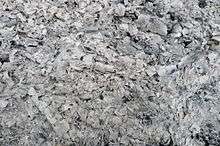Ash
Ash or ashes are the solid remains of fires.[1] Specifically, it refers to all non-aqueous, non-gaseous residues that remain after something is burned. In analytical chemistry, in order to analyse the mineral and metal content of chemical samples, ash is the non-gaseous, non-liquid residue after a complete combustion.

Ashes as the end product of incomplete combustion will be mostly mineral, but usually still contain an amount of combustible organic or other oxidizable residues. The best-known type of ash is wood ash, as a product of wood combustion in campfires, fireplaces, etc. The darker the wood ashes, the higher the content of remaining charcoal will be due to incomplete combustion.
Like soap, ash is also a disinfecting agent (alkaline).[2] The World Health Organization recommends ash or sand as alternative when soap is not available.[3]
Specific types
- Wood ash
- Products of coal combustion
- Bottom ash
- Fly ash, product of coal combustion
- Breeze, ash recovered from burning urban rubbish
- Cigarette or cigar ash, the ash produced when a cigarette or a cigar is smoked
- Incinerator bottom ash, a form of ash produced in incinerators
- Vibhuti, ash used in Hindu rituals
- Ashes and dried bone fragments, or "cremains", left from cremation
- Volcanic ash, ash that consists of glass, rock, and other minerals that appears during an eruption
See also
References
- "the definition of ash". www.dictionary.com. Retrieved 2018-06-18.
- Howard et al. 2002: Healthy Villages A guide for communities and community health workers. CHAPTER 8 Personal, domestic and community hygiene. WHO. Accessed Oct. 2014. http://www.who.int/water_sanitation_health/hygiene/settings/hvchap8.pdf
- WHO 2014: Water Sanitation Health. How can personal hygiene be maintained in difficult circumstances? Accessed Oct. 2014 http://www.who.int/water_sanitation_health/emergencies/qa/emergencies_qa17/en/